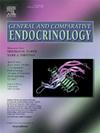斑马雀(Taeniopygia castanotis)在恒定光照下表现出不同程度的应激恢复能力和复原能力。
IF 1.7
3区 医学
Q3 ENDOCRINOLOGY & METABOLISM
引用次数: 0
摘要
性状从应激源中恢复的能力各不相同,取决于应激源的强度、持续时间或类型。夜间人造光(ALAN)造成的昼夜节律紊乱就是这样一种压力源。昼夜节律紊乱可能会导致长期的生理后果;然而,个体对恢复做出反应并表现出应激复原力的能力尚不清楚。在此,我们将斑马雀(Taeniopygia castanotis)暴露于恒定光照(24L:0D)或常规光/暗循环(14L:10D)下23天,并进行为期12天的恢复期。我们测量了恒定光照之前、期间和之后的体重、皮质酮和葡萄糖水平,以及死亡时糖皮质激素受体的相对蛋白丰度。与正常光照/黑暗周期下的鸟类相比,光照暴露下的鸟类体重随时间显著增加,但12天的恢复期逆转了这种增加。与对照组相比,光照暴露鸟类的循环葡萄糖基线水平有所下降,但在12天的恢复期后又显著上升。相比之下,在光照暴露的鸟类中,葡萄糖应激反应没有表现出与体重或基线葡萄糖类似的恢复趋势。在整个实验过程中,我们没有检测到两组鸟的基线皮质酮或应激反应性发生任何变化。最后,我们发现光照暴露组鸟类死亡时糖皮质激素受体的蛋白质丰度更高。我们的研究结果表明,生理和形态特征对恒定光照的恢复能力各不相同,因此有必要进一步研究在昼夜节律紊乱情况下应激恢复能力的驱动机制。本文章由计算机程序翻译,如有差异,请以英文原文为准。
Zebra finches (Taeniopygia castanotis) display varying degrees of stress resilience in response to constant light
The ability for traits to recover after exposure to stress varies depending on the magnitude, duration, or type of stressor. One such stressor is circadian rhythm disruption stemming from exposure to light at night. Circadian rhythm disruption may lead to long-term physiological consequences; however, the capacity in which individuals recover and display stress resilience is not known. Here, we exposed zebra finches (Taeniopygia castanotis) to constant light (24L:0D) or a regular light/dark cycle (14L:10D) for 23 days, followed by a recovery period for 12 days. We measured body mass, corticosterone, and glucose levels at multiple timepoints, and relative protein expression of glucocorticoid receptors at euthanasia. Body mass significantly increased over time in light-exposed birds compared to controls, but a 12-day recovery period reversed this increase. Baseline levels of circulating glucose decreased in light-exposed birds compared to controls, but returned to pretreatment levels after the 12-day recovery period. In contrast, the glucose stress response did not show a similar recovery trend, suggesting longer recovery is needed or that this is a persistent effect in light-exposed birds. Surprisingly, we did not detect any differences in baseline corticosterone or reactivity of the hypothalamic-pituitiary-adrenal (HPA) axis between groups throughout the experiment. Moreover, we did not detect differences between relative protein expression of glucocorticoid receptors or a relationship with HPA axis reactivity. Yet, we found a positive relationship between glucocorticoid receptors and the glucose stress response, but only in the light group. Our results indicate that physiological and morphological traits differ in their ability to recover in response to constant light and warrants further investigation on the mechanisms driving stress resilience under a disrupted circadian rhythm.
求助全文
通过发布文献求助,成功后即可免费获取论文全文。
去求助
来源期刊

General and comparative endocrinology
医学-内分泌学与代谢
CiteScore
5.60
自引率
7.40%
发文量
120
审稿时长
2 months
期刊介绍:
General and Comparative Endocrinology publishes articles concerned with the many complexities of vertebrate and invertebrate endocrine systems at the sub-molecular, molecular, cellular and organismal levels of analysis.
 求助内容:
求助内容: 应助结果提醒方式:
应助结果提醒方式:


